Inherited Fashion: The Culture Clash Between My Mother’s Closet and My Own
What do I do with all the Indian clothes my mother gifted me?
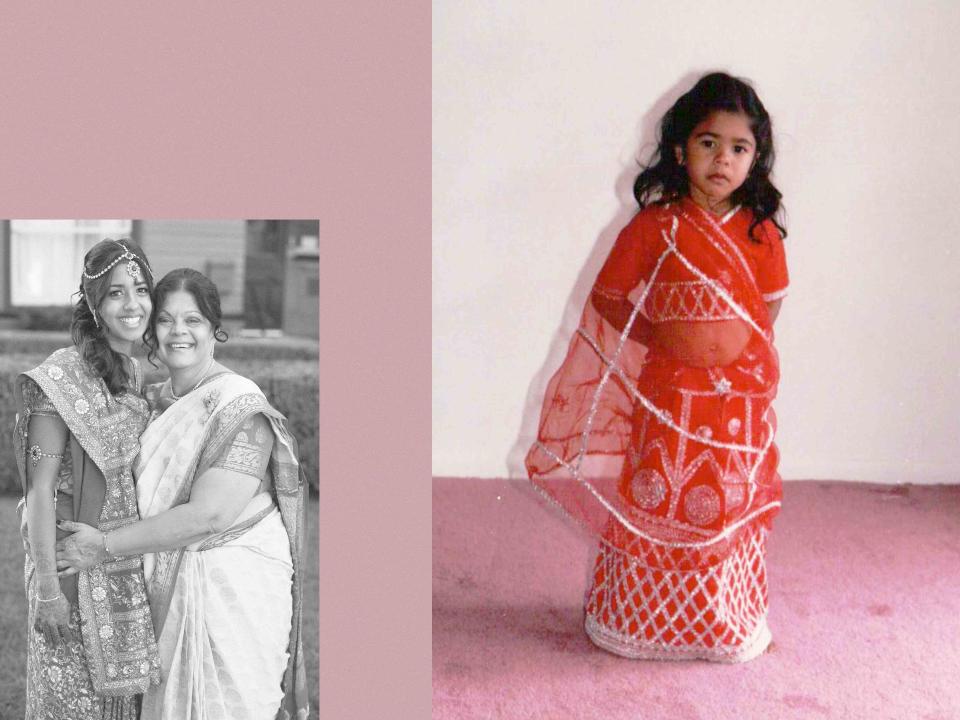
Courtesy of Avni Shah/ InStyle
I can still remember all my favorite outfits from childhood: a cream-colored sweater with emerald-green glitter sprinkled diagonally across it; a white and red smocked sundress; a black dress from Delia’s (remember Delia’s?) with sheer puff sleeves and baby blue embroidery.
Another favorite: a red-and-silver skirt-and-blouse combo my parents purchased from India with a red, sheer piece of cloth my mom had pinned to perfection. I wore it when I was 4 years old—a truth captured only in pictures.
Born in New York and raised in New Jersey, my definition of beauty came from American magazines: Vogue and Elle, InStyle and Bazaar, pages of which I thumbed through in waiting rooms or at the library. Glossy images of Cindy Crawford and Kate Moss dressed with enviable flair made me want to step up my own fashion game—though I had no budget or autonomy with which to try. They were the epitome of cool; self-actualized to the point of domination.
My mother was born and raised in Gujarat, India, and moved to the U.S. when she was in her 20s. For her, women to envy came from Bollywood: Madhuri Dixit, Shridevi. She dressed loudly, in bold colors and patterns that made even Versace seem ordinary. The bulk of her closet was filled with silk saris and warm, wool shawls to throw over them on a cool night. There was a small selection of floral midi skirts and blouses that she wore to the bank where she worked. It was the one place where she abided by an American dress code.
On our quadrennial trips to India—starting when I was just 4 years old—we would spend hours in boutiques. Shopkeepers would serve us chai and soft drinks while we had them unfold compressed squares of fabric. Piece after piece, we were surprised by what was inside the plastic wrap, looking for the garments that were special enough for which to negotiate a price. In those shops, I was like any child who is in the process of being spoiled: undiscerning, excited, desirous. If my parents were willing to pay, I’d say yes to dozens of outfits I didn’t need or know how to wear. All I wanted was to own them.
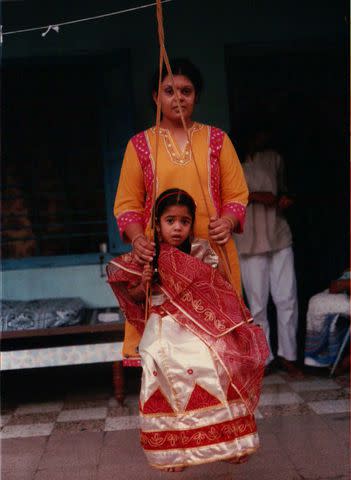
Courtesy of Avni Shah/ InStyle
Avni and her mother visiting Gujarat, India.In the context of Indian society, everything seemed beautiful—no matter how unforgivingly the colors clashed (magenta on Minute Maid orange; chartreuse and royal purple) or how oddly the fabrics draped over my hunched frame. (I’ve always had terrible posture, but it was worse back then.) But back home in New Jersey, the same garments felt anachronistic. Even when my dad gushed about how beautiful I looked, clicking shots with his treasured Canon, I felt neighbors’ eyes boring into me. Over the years, I heard errant comments about how we looked: adult confusion at why saris were so “revealing” or kids taunting us with words like “red dot” to deride the bindi that is meant to be worn with great pride and pleasure. When people told me that their inquisition was out of deep curiosity and admiration, I knew this wasn’t the whole truth.
As I grew older, my mother and I increasingly clashed. She wished I had more Indian friends, and I wished she would spend more money on American clothes. I wanted Gap jeans and Nikes; I wanted to be cool. But she kept buying me easily wrinkled crepe fabrics in colors no one else wore, outfits that matched only with gold or silver sandals that looked like pageant-wear you might pick up at a kiosk on the Jersey shore.
The frustration was mutual, and I regarded my mother’s fashion choices with the same judgmental gaze she did mine. Insisting on wearing saris everywhere, she shocked me when she put one on—navy blue and magenta with peacocks embroidered into yards of fabric—for her Italian boss’ traditional Catholic wedding. I found it tacky, akin to showing up in white. I told her she should adhere to the understood dress code: a dress, maybe a fancy skirt and top. “The focus shouldn’t be on you or India,” I said. She didn’t relent.
As a college student at New York University, I started a work study job and a bank account. From my weekly paychecks, I began buying the clothes I’d always wished I could own. I bought sneakers from Puma and Diesel, and arm warmers from Urban Outfitters. I toyed with buying a dress from DKNY that I thought would change my life completely—army green lined with a brighter green tulle at the bottom of the skirt. It was $300 and, in the times before smartphones, I had a lot of trouble finding the store.
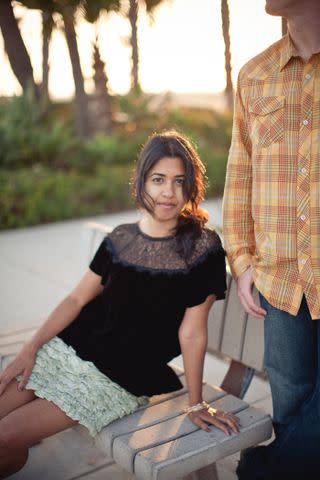
Courtesy of Avni Shah/ InStyle
An engagement photoshoot in Newport Beach, CA. Free People lace top and J. Crew ruffle skirt.When I was 23 years old, I moved to Los Angeles. This time I had three suitcases and still, none of them carried my Indian clothes. I brought bangles and shawls, which I often wore to bars. My friends found it peculiar—perhaps an “east coast thing.” I went to Anthropologie and bought sundresses, and shopped surf brands like Roxy for new tank tops I could wear in 75-degrees-and-sunny. But it would be years before I visited Artesia, the area of Los Angeles County where many Indian shops and restaurants are located.
Every time my parents visited, my mom delivered several Indian fashion relics from the closet she’d preserved for me back home.
“There’s no point in my keeping these,” she’d say. “You should use them.”
I carried a dozen outfits from Pasadena to Venice to El Segundo, because I didn’t have the heart to tell my mother I had no use for them. I knew they were expensive, but I couldn’t discern their value. What was the secondary market for these items? Should I have them made into skirts and tops? Is there a place to donate old Indian luxury items? I certainly couldn’t ask my mother; it would offend her. So I held on to them, though they were becoming tighter and dustier and more dated.
After a few months of settling in, I spent my first Diwali and Indian New Year away from home. Without my mother there forcing me to dress up for a traditional, homemade dinner she’d host, the holidays seemed made-up and empty. I wondered where exactly all the Indian people were and where Indian traditions were collectively celebrated. Each passing year, I felt more distant from my childhood and more confused about what it meant to be an Indian-American. Without my mother’s guiding hand—what to wear, what to eat and when—I felt like an imposter.
One year, the guilt consumed me. That Diwali, I tried to put myself in my mother’s shoes. I stopped at Samosa House, a Los Angeles-based Indian grocery store. I grabbed frozen chapati and samosas and turmeric and Limca—a lemon-lime soda sold at food stands all over India. There was no rhyme or reason. Just nostalgia and perhaps, desperation. In the moment, I think I felt I’d failed my cultural upbringing. I could hear my mother’s voice on the other end of the phone asking for proof I planned to celebrate, that all those rituals she’d taught me would come to fruition.
In New Jersey, my parents had created a family of friends. Our gatherings were 20 to 30 people deep and full of homemade dishes. In Los Angeles, I served dinner to my then-boyfriend (now husband) alone. I wore one of my ill-fitting outfits: a pink and blue salwar kameez covered in white and silver accents. It was neither comfortable nor binding, but it felt completely unnatural, like a costume. It made me think of all those times my parents had urged me to be an Indian princess for Halloween. I wondered if they knew how it would make me feel inauthentic.
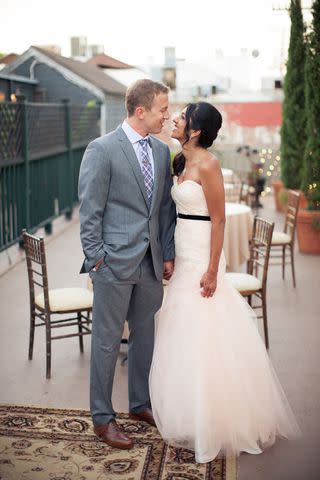
Courtesy of Avni Shah/ InStyle
Avni with her husband Andy on their wedding day in 2012. The reception dress was custom made in LA’s Koreatown.Every year after, I managed some variation of this “tradition.” Once I had children, I dressed them up, too—in outfits we had been gifted by my brother’s in-laws for a wedding. The antiquated designs and poor fit suited the kids much more; the sweetness of youth allows sartorial experiments to be much more forgiving.
But to this day, my closet calls to me in an accusatory tone. I don’t know what to do with the clothes trapped inside. I don’t know where they should go, if not on me. I’d rather wear one of the dresses I’ve shopped for online and felt excited to purchase for too much money. Dresses that made me feel cute and sexy and svelte and unique in a way my Indian clothes never did.
Last summer, my friend got married and another opportunity to wear my Indian clothes presented itself. Looking at my closet, I wondered if I should reuse one of the wasted pieces of clothing my mom had passed on to me. But looking at each of them, I knew I’d feel terrible in their itchy, stiff, old-fashioned fabrics. It was time to take the same approach to shopping for Indian clothes as I do with my Western clothes.
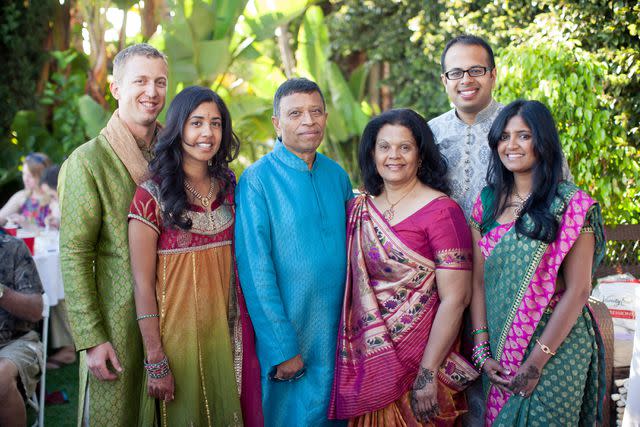
Courtesy of Avni Shah/ InStyle
Avni with her parents, brother, and sister-in-law at the traditional henna party (mehndi) to celebrate her wedding.So I went online, trying to find the best purveyors of authentic, on-trend Indian outfits. I perused dozens of options across a handful of websites, finally landing on Kalki Fashion. Straight from Mumbai, I could get affordable, modern, in-season pieces that appealed not just to Indian cultural norms but to my own sartorial curiosity and excitement. I chose a chartreuse and hot pink tie-dye piece with a sleeveless, high-low top and elastic, straight leg bottoms. It was unlike any piece my mother had ever bought for me—modern, quirky, yet still traditional.
My mother was confused as to why I bought a new outfit when I had so many old ones.
“I just wanted to,” I replied, not sure how to explain it. Immediately, I felt guilty. Was I being wasteful? Why did I need to start from scratch?
A couple months later, my mom asked how my husband and I planned to celebrate our wedding anniversary.
“A museum,” I said. We were going to see the Keith Haring exhibit at The Broad in downtown Los Angeles. “Then dinner.”
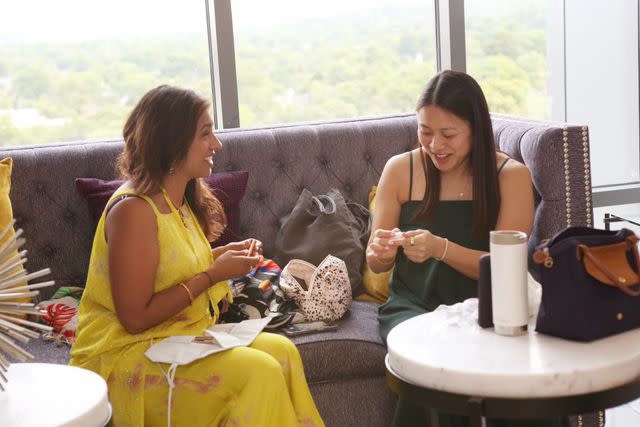
Courtesy of Avni Shah/ InStyle
Avni and a close friend getting ready for a friend’s pre-wedding ceremony in DC. The modern salwar kameez was the first she purchased on her own.“You should wear your new outfit,” she told me.
I considered it. It was fashion forward, nearly a fusion piece. But all I could think of was how odd it would seem in a sea of black dresses and skinny jeans. What kind of statement would it make?
For my mother, I realized, it was never about making one statement or another. It was about growing her personal style, finding her own way to fit in. To this day, she pairs jeans or leggings with India-sourced tunic tops that boast elaborate embroidery in bright, clashing colors and traditional Indian patterns, like bandhini and ikat. It’s a fusion that represents her, and that she easily owns. All those years, I thought she didn’t understand how to dress. That her choices were stubborn or haphazard. But I realize now she knew how to stay true to herself while experimenting and adapting. What she was able to do, only the most fashion-forward individuals can: Use clothes to represent who they are culturally and specifically. Her clothes were never of one world, but rather, influenced by her affection for parts of different ones. It’s this bridge between cultures I’m still trying to form, one outfit at a time.
For more InStyle news, make sure to sign up for our newsletter!
Read the original article on InStyle.


